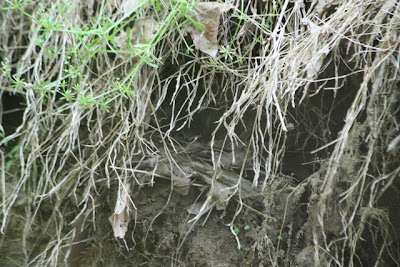I grew up with red-headed woodpeckers in Richmond, Virginia. There was a housing development where one of my friends lived that was lousy with them. Even though I could see them any time I wanted, I still thought they were special. One of my earliest rehab patients was a car-hit red-headed woodpecker. Such a spirited bird, so willing, so full of life. Too bad it ended badly. I learned the hard lesson at eight that you don't take a wild bird with a broken wing to a dog and large animal vet. It isn't fair to either of them. Still, I got to know a little something of the red-headed woodpecker's spirit. What a wonderful bird he was, even grounded and scuttling around in a cardboard box.
The high, hoarse Queerk! of the red-headed woodpecker electrifies me to this day. Bill and I thought we'd landed on Planet Paradise when it hit us that we were in the midst of a RHWO colony at North Bend State Park in western West Virginia.
We found three nests, and had we headed to our left, we'd have probably found at least that many more. But we had our hands full discovering everything there was in one short traverse of the lake.
Bill of the Birds settled back, trying to get acceptable images of a shy pair tending their young. To combat drift, you have to hang yourself up in a snag to still the canoe. They like to faunch around when you're trying to get your shot.
Technically, a 300 mm. telephoto isn't quite enough glass for this situation. I'm thinking hard about upgrading my camera equipment, getting a lens I can put a doubler on. I just wanted to be closer to these birds, but they were skittish as could be, and I never got the photos I wanted. Still, some are evocative of the moments I experienced.
This lovely bird stopped to sunbathe, drooping his wing.
They looked so beautiful against the weathered trunks. Even as I enjoyed the afternoon, I was trying to figure out when and how I could get back before the babies (which were peeping weakly in the cavities) were out of the nest.
It's been such a busy summer. The first part of June was given to North Dakota, and the minute we got back the kid-maintenance appointments started--teeth, eyes, hair. More teeth. More eyes. Physicals. Everyone needing maintenance. Is it any wonder Mom lets hers slide? I'm writing this from the waiting room of an oral surgeon who at this moment is taking six (yes, our kids are extraordinary in every way) wisdom teeth out of poor Phoebe's jaws. This is the second time I've seen one of my babies go under anaesthesia, and it runs counter to every fiber in my being to witness that. It's like sending them to the Underworld. She'll be fine, she's got a momma making Vicodin smoothies. Hangin' in there...dreaming of canoeing on this fine puffy white cloud summer day; just not able to do it right now. I'm sure that's a familiar feeling to many of you all. Send your good wishes to our poor lil' flame-haired Chipmunk. She needs them.
Mimi darling, it was such a tonic to see you. I needed those hugs!






















































